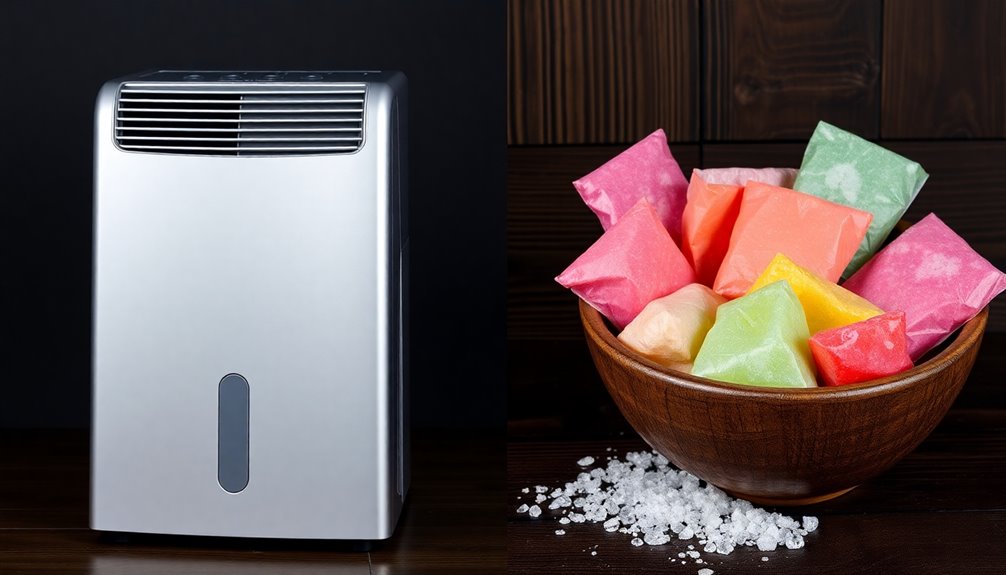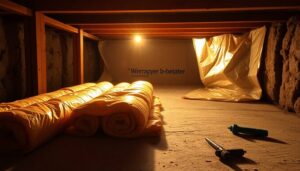When you're weighing silica gel against electric dehumidifiers, cost and effectiveness are key. Silica gel packs are budget-friendly, priced around $10-$30, and work well in small spaces by absorbing moisture. They're reusable but require occasional reactivation. On the other hand, electric dehumidifiers range from $100-$300 and are more effective for larger areas, especially in high humidity. While they have higher upfront costs, their efficiency can save you money over time. Both options have their pros and cons, so stick around to uncover the best choice for your specific humidity control needs.
Understanding Moisture Control
When it comes to maintaining a comfortable environment, understanding moisture control is essential. You need to recognize the difference between various methods, particularly when choosing between desiccant options and electric dehumidifiers.
Desiccants, like silica gel, play a vital role in small spaces by adsorbing moisture from the air. They're cost-effective, but their effectiveness is limited to specific conditions and spaces. Regular reviews of your financial health can help determine if investing in a more robust solution is necessary. Additionally, using budgeting apps can help you allocate funds for such investments effectively.
On the other hand, desiccant dehumidifiers can achieve impressive humidity levels as low as 30%, even in cooler temperatures where traditional electric models may struggle. These devices utilize materials like silica gel or zeolite and can extract up to 500ml of moisture per kWh, making them highly efficient for continuous moisture control.
Rechargeable silica gel dehumidifiers can be refreshed through heating, allowing for repeated use, but they're best suited for minor moisture issues.
If you're dealing with larger areas or significant humidity problems, electric dehumidifiers may be the better choice, despite their higher power requirements. Understanding these differences will help you choose the right moisture control solution for your environment. Additionally, utilizing expense management apps can streamline your financial organization, enhancing your overall budgeting and planning strategies.
What Is Silica Gel?
Silica gel is a granular form of silicon dioxide that's designed to absorb moisture and keep your environment dry.
Its unique composition allows it to hold up to 40% of its weight in water, making it a practical choice for various applications. Investment tracking tools can also provide insights into the costs associated with maintaining a dry environment, ensuring efficient spending. Additionally, utilizing coupon codes can help you save money on purchasing silica gel and other moisture control products. You'll find it in everything from food packaging to electronics, ensuring they stay moisture-free. Additionally, expense tracking apps can help manage costs related to moisture control products like silica gel, enhancing overall financial efficiency.
Composition and Properties
A small packet of silica gel may seem insignificant, but it's packed with powerful moisture-absorbing properties. Silica gel is a granular, porous form of silicon dioxide (SiO2), which is its primary composition. This unique structure gives it a remarkably high surface area, allowing it to adsorb up to 40% of its weight in moisture.
It's this capability that makes silica gel an effective choice for controlling humidity in enclosed spaces.
One of the key properties of silica gel is its non-toxic nature, making it safe for various applications, including food and electronics storage. You can even reuse it! By heating silica gel in an oven, you can regenerate its moisture-absorbing capacity, extending its lifespan.
Typically found in small packets or canisters, silica gel protects products during shipping and storage, ensuring they remain dry.
However, while it's an economical option for small-scale moisture control, remember that it's less effective than dehumidifiers in larger areas or spaces with high humidity levels.
Moisture Absorption Mechanism
Moisture control in enclosed spaces relies on various methods, and silica gel employs a fascinating moisture absorption mechanism. This desiccant works through a process called adsorption, where water molecules from the air are attracted to and held on the surface of silica particles.
Each silica gel particle has a high surface area, allowing it to absorb up to 40% of its weight in moisture from the air, making it highly effective in reducing humidity levels in small, contained areas.
One of the key advantages of silica gel is that it's non-toxic and reusable. After absorbing moisture, you can easily recharge it by heating the silica gel in an oven, evaporating the absorbed moisture and restoring its effectiveness.
Unlike electric dehumidifiers, silica gel doesn't require power, providing a cost-effective solution for managing humidity.
You might find silica gel in small packets within packaging, helping to protect products from moisture damage during storage and shipping.
Common Applications and Uses
Countless applications highlight the versatility of silica gel in everyday life. This moisture-absorbing material, made from silicon dioxide, helps protect items from humidity damage. You'll often find silica gel packets in shoeboxes, vitamin bottles, and food containers, where they maintain ideal moisture levels in confined spaces.
Silica gel's common applications extend beyond just packaging; it's widely used in electronics, pharmaceuticals, and food products to prevent spoilage and degradation due to humidity. Since these packets are typically low-cost—often less than a dollar each—they're an economical choice for moisture management.
Unlike dehumidifiers that actively remove moisture from larger areas, silica gel excels in small, enclosed environments. You can easily tuck packets into drawers, closets, or storage bins, ensuring that your belongings remain dry and protected.
Whether you're preserving important documents, keeping your tech safe, or extending the shelf life of your food, silica gel proves to be a reliable ally against moisture. This makes it a practical solution for anyone looking to safeguard their items without breaking the bank.
How Dehumidifiers Work
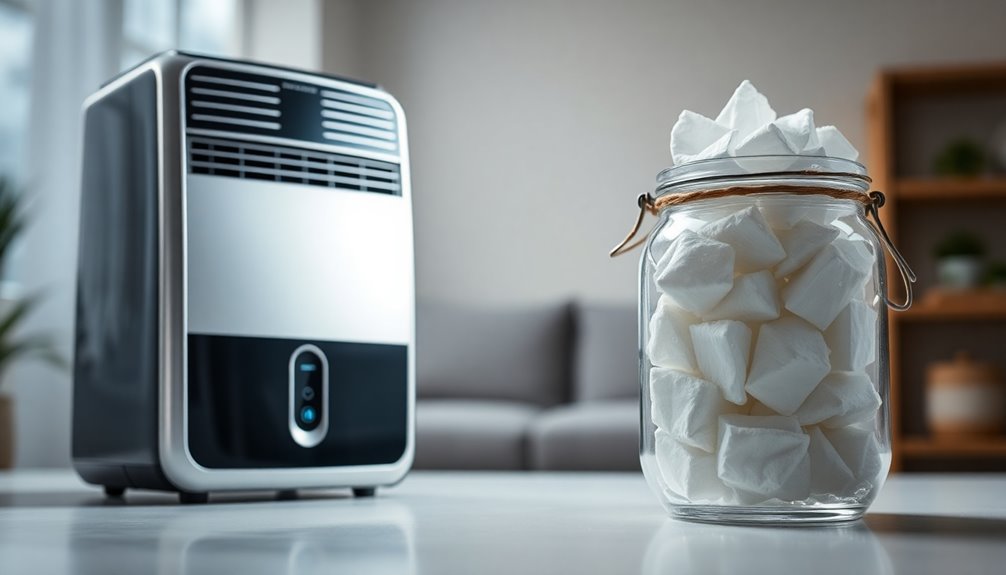
Understanding how dehumidifiers work can help you choose the right one for your needs. Dehumidifiers remove moisture from the air, which can greatly improve indoor comfort and air quality. There are two main types: compressor and desiccant models, each using different mechanisms to achieve moisture removal.
Compressor dehumidifiers operate by condensation, cooling the air to convert water vapor into liquid. This makes them particularly effective in warm climates. On the other hand, desiccant dehumidifiers use a special material that adsorbs moisture, functioning well in both hot and cold environments. They can even reach lower humidity levels—down to 30%—regardless of temperature. Additionally, automated investment management tools can be useful for budgeting for larger purchases like dehumidifiers. Expense categorization is essential for tracking the overall costs associated with maintaining a home environment effectively.
If noise is a concern for you, electric desiccant dehumidifiers often operate quietly, typically below 40 dB, making them suitable for residential use without disturbing your peace.
Maintenance differs too; desiccant models generally require no draining or upkeep due to their regenerative capabilities, while compressor models may need regular servicing to maintain efficiency. Additionally, expense tracking tools can help you manage the costs associated with purchasing and maintaining a dehumidifier effectively.
Types of Dehumidifiers
When it comes to controlling humidity levels, knowing the different types of dehumidifiers can make a big difference in your choice.
There are three main types: Peltier, compressor, and desiccant. Each type has distinct mechanisms for moisture removal and varying sizes suited for different spaces. Additionally, choosing the right type can significantly impact your environmental impact due to their varying energy efficiencies. Ethical shopping practices encourage consumers to consider the sustainability of the products they purchase, including energy-efficient dehumidifiers.
Peltier dehumidifiers are compact and perfect for smaller areas, extracting around 250ml of moisture daily. However, they're less energy-efficient compared to larger models.
If you're in a warmer climate, a compressor dehumidifier might be your best bet. They operate efficiently above 20°C and consume less energy than desiccant types, though they struggle in cooler conditions.
On the other hand, desiccant dehumidifiers shine in low temperatures, achieving humidity levels as low as 30%. They're ideal for both hot and cold climates and operate quietly, making them a great choice for living spaces.
Lastly, don't overlook non-electric options like silica gel models. These can be recharged periodically, offering a cost-effective solution for enclosed spaces. Additionally, considering sustainable delivery practices can help minimize your environmental impact when purchasing dehumidifiers online.
Knowing the types and sizes of dehumidifiers available helps you find the right fit for your needs.
Cost Comparison Overview
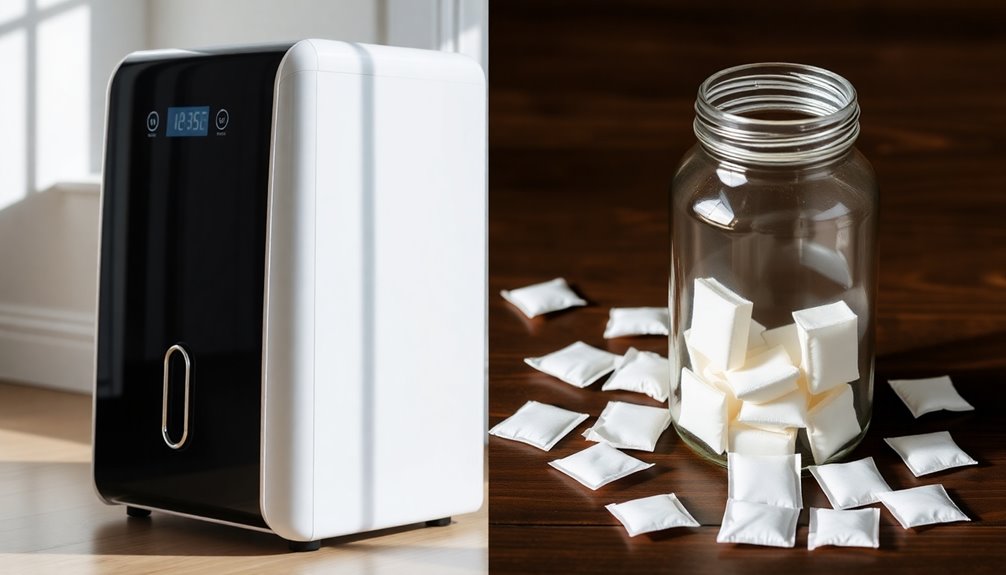
When weighing your options between silica and dehumidifiers, it's important to evaluate both initial purchase costs and ongoing operating expenses. While silica gel packs are budget-friendly upfront, electric compressor and desiccant models may have higher initial investments but can offer better long-term effectiveness in managing humidity. Additionally, using price comparison tools can help you find the best deals on both silica products and dehumidifiers. One effective strategy is to utilize multiple comparison platforms to ensure that you are getting the best price available. Furthermore, some tools like Google Shopping provide access to a wide range of products and valuable metrics that can enhance your shopping experience. Ultimately, reviewing these factors will help you choose the best solution for your specific needs.
Initial Purchase Costs
Taking into account the initial purchase costs, silica gel dehumidifiers present a budget-friendly option for those looking to manage humidity on a smaller scale.
Typically, you can find small silica gel units priced between $10 and $30, making them an affordable choice for tight budgets. In contrast, electric dehumidifiers range from $100 to $300, which can be quite a jump in expense.
Rechargeable silica gel dehumidifiers can be reused multiple times, requiring only occasional heating to refresh their moisture-absorbing capacity. This feature enhances their cost-effectiveness over time, especially if you need a solution for smaller, enclosed spaces.
While electric models might offer more efficient moisture removal for larger areas, their higher initial purchase costs are something to take into account.
If you only need to control humidity in a small room, silica gel options are cheaper upfront. However, if you're tackling extensive humidity issues in a larger living space, investing in an electric dehumidifier might be more suitable despite the higher initial costs.
Ultimately, your choice will depend on the specific humidity control needs and your budget constraints.
Operating Expenses Comparison
After evaluating the initial purchase costs, it's important to look at the operating expenses associated with silica gel and electric dehumidifiers.
In this operating expenses comparison, silica gel dehumidifiers emerge as a cost-effective choice, typically costing around 34 cents per litre for moisture control in small spaces. Rechargeable silica gel models further reduce costs, requiring only periodic heating to recharge, making them ideal for long-term use.
On the other hand, electric dehumidifiers vary in operating costs based on their type and the environment. For instance, desiccant dehumidifiers consume about 37.4 cents per litre in energy, which is efficient for consistent, year-round humidity control.
Meanwhile, compressor dehumidifiers can be economical in warmer conditions at around 17 cents per litre but struggle in colder environments, where costs can soar to 34 cents per litre.
Ultimately, your choice may depend on the scale of moisture control needed. If you're managing humidity in small, enclosed spaces, silica gel is likely your best bet.
For larger areas with significant humidity issues, electric dehumidifiers might prove more effective despite higher operating expenses.
Long-Term Effectiveness Analysis
Long-term effectiveness in moisture control is essential for maintaining a healthy environment, and understanding the cost implications of silica gel versus electric dehumidifiers is key.
When conducting a long-term effectiveness analysis, you'll find that while silica gel dehumidifiers are inexpensive and reusable, they often require periodic heating to recharge, which can add to your energy bills over time.
On the other hand, electric desiccant dehumidifiers can lower humidity levels to as low as 30%, making them ideal for various conditions. Although their running cost averages around 37.4 cents per liter of moisture extracted, the initial investment may pay off in the long run.
Silica gel solutions typically cost less, at around 34 cents per liter, but their moisture control can falter in larger or more humid spaces.
In the long haul, desiccant dehumidifiers provide more consistent moisture management, reducing potential expenses related to mold prevention and maintaining indoor air quality.
Ultimately, while silica gel might seem cheaper upfront, investing in a desiccant system could lead to greater savings and better health outcomes over time.
Effectiveness of Silica Gel
How effective is silica gel in managing humidity? Silica gel is a powerful desiccant that excels at adsorbing moisture from the air, making it ideal for small, enclosed spaces like drawers and storage containers.
It operates by attracting and holding water vapor, typically reducing humidity levels to around 40% to 50% relative humidity. This effectiveness of silica gel allows you to prevent dampness in various applications without relying on electricity.
One significant advantage is that silica gel can absorb up to 40% of its weight in moisture, making it a cost-effective solution.
Plus, the recharge process is simple—just heat it in an oven to restore its moisture-absorbing capacity, allowing for multiple uses.
However, while silica gel is effective in small areas, you should note that it may not perform as well in larger spaces where extensive moisture control is necessary.
For those situations, you might need to contemplate other options. Overall, if you're looking for an economical way to manage humidity in confined spaces, silica gel is definitely worth pondering.
Efficiency of Dehumidifiers
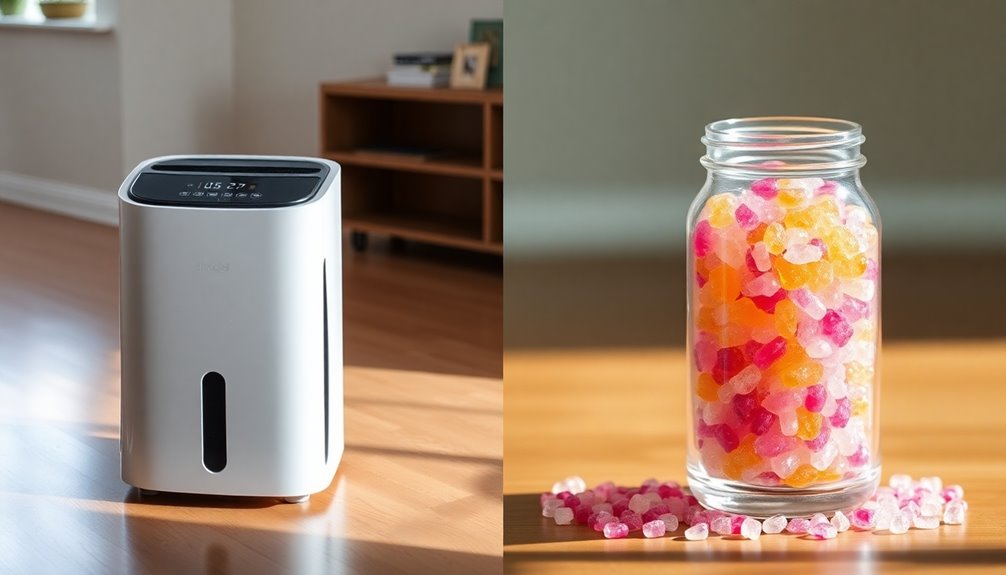
When it comes to efficiency, understanding energy consumption is essential for choosing the right dehumidifier.
You'll find that extraction rates and operating costs vary greatly between different models, impacting your overall investment.
Let's break down how these factors play into the effectiveness of dehumidifiers compared to silica gel.
Energy Consumption Analysis
Understanding the energy consumption of dehumidifiers is essential for making an informed choice.
In your energy consumption analysis, you'll find that compressor dehumidifiers generally consume less energy than desiccant models. For instance, a 12L compressor unit running at 240W can collect about 4L per day at 20°C and 60% humidity. This leads to a running cost of approximately 17 cents per litre in warm rooms, which doubles to 34 cents in colder conditions.
In contrast, desiccant models extract around 500ml per kWh on high settings, costing about 43 cents per litre. While they perform well in extreme temperatures, their higher operational costs can be a drawback.
Peltier dehumidifiers, although less common, are even less efficient, extracting only 250ml per day and costing around 99 cents per litre.
Extraction Rate Comparison
Extraction rates play an essential role in determining the efficiency of different dehumidifiers. When you're choosing a unit, it's vital to understand how well each type performs in various conditions.
Here's a quick comparison of extraction rates:
- Desiccant dehumidifiers: Achieve about 500ml/kWh on high, excelling in moisture removal.
- Compressor dehumidifiers: Struggle at low temperatures, often operating at about 1/3 efficiency at 20°C and 60% relative humidity.
- Peltier dehumidifiers: Average around 250ml/day, which isn't ideal for larger spaces.
- Rechargeable silica gel dehumidifiers: Effective in small areas but have a noticeably lower extraction rate than electric models.
- Overall efficiency: Compressor models see their performance drop drastically in colder environments, making extraction rate comparison essential for your needs.
Understanding these differences helps you choose the right dehumidifier for your space.
If you're looking for powerful moisture removal, desiccant models are your best bet. However, if you're in a warmer environment, compressor units can still be effective, just keep their limitations in mind.
Operating Cost Overview
Choosing the right dehumidifier isn't just about extraction rates; operating costs are a significant factor to take into account. In this operating cost overview, you'll find that desiccant dehumidifiers excel in low-temperature environments, pulling about 500ml of moisture per kWh. However, they come with a cost of around 37.4 cents per litre of moisture removed.
On the other hand, compressor dehumidifiers typically extract moisture at one-third of their rated capacity at 20°C and 60% relative humidity, with running costs averaging between 17 and 34 cents per litre, depending on the conditions.
If you're considering less common options, Peltier dehumidifiers extract about 250ml per day but at a higher cost of roughly 99 cents per litre.
In smaller spaces, rechargeable silica gel moisture absorbers can be a cost-effective alternative, running at around 34 cents per litre. They do require periodic recharging, which you'll need to factor in.
Maintenance and Lifespan
When it comes to maintenance and lifespan, silica gel dehumidifiers and electric models offer distinctly different experiences. If you're considering which option to choose, here are some key points to keep in mind:
- Silica gel dehumidifiers need periodic heating to recharge.
- Electric models require regular maintenance like filter cleaning and reservoir emptying.
- Lifespan of silica gel products varies, lasting several months to a year.
- Electric dehumidifiers typically last 5 to 10 years with proper care.
- Silica gel can be reused multiple times, making it a more sustainable choice.
Silica gel is a low-maintenance solution ideal for small, enclosed spaces, while electric dehumidifiers might require more attention, especially in larger areas.
The latter can incur higher long-term costs due to electricity consumption and potential repairs. However, if you need consistent moisture control in cooler temperatures, silica gel models excel without the hassle of draining.
Ultimately, your choice will hinge on your specific needs, whether you prefer the ease of silica or the longevity of electric dehumidifiers.
Environmental Impact Considerations
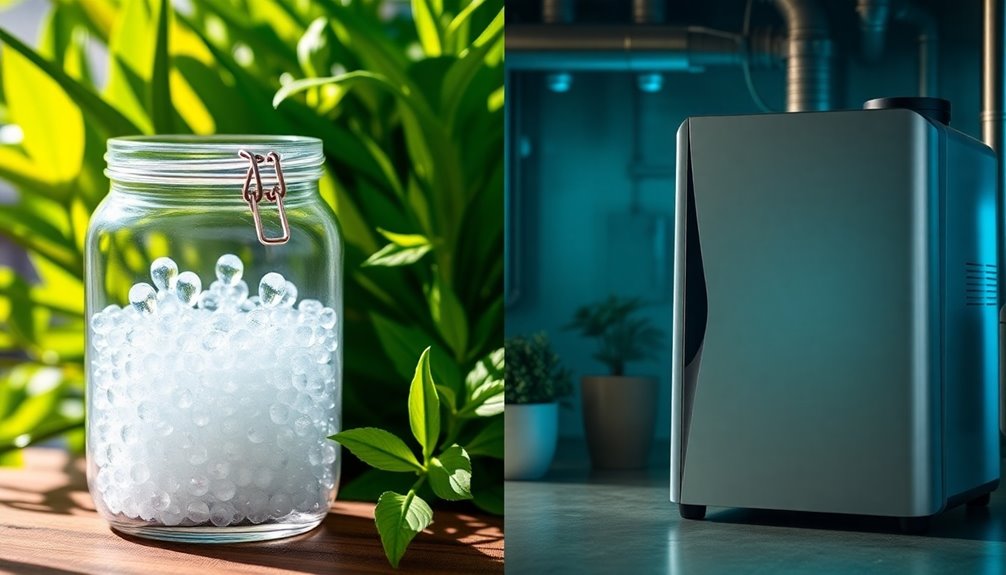
When considering environmental impact, you should compare the resource consumption of silica gel and electric dehumidifiers.
While silica gel can be reused and doesn't require electricity, conventional dehumidifiers often contribute to electronic waste through their production and disposal.
Understanding their longevity and how they affect waste management practices can help you make a more sustainable choice.
Resource Consumption Comparison
Silica gel's appeal lies in its minimal environmental impact compared to electric dehumidifiers. When you consider resource consumption, silica gel emerges as a more sustainable choice. Here are some key points to ponder:
- Cost-Effective: Silica gel costs around $10 for a 1-pound bag, while dehumidifiers range from $150 to $400.
- Energy-Free: Silica gel absorbs moisture without using electricity, making it ideal for low-power settings.
- Reusable: Rechargeable silica gel can be heated and reused, unlike dehumidifiers that incur ongoing electricity costs.
- Lower Environmental Impact: Desiccant dehumidifiers operate efficiently in low temperatures, consuming less energy than compressor models.
- Performance Variability: Silica gel's effectiveness diminishes when saturated, requiring replacement or recharge, whereas electric units maintain performance until maintenance is needed.
In terms of resource consumption, your choices impact both your wallet and the environment.
While electric dehumidifiers provide consistent moisture control, they demand a higher energy input and costs over time.
Silica gel, with its low environmental footprint and minimal resource consumption, offers a compelling alternative for those looking to reduce their ecological impact.
Waste Management Practices
Effective waste management practices play an essential role in mitigating environmental impact. By adopting these practices, you can help divert waste from landfills, where harmful greenhouse gases like methane are produced.
Recycling materials such as glass, paper, and metals not only saves energy but also cuts down on pollution, since recycling generally requires less energy than creating new materials from scratch.
Composting organic waste is another effective waste management practice. It reduces landfill use while enriching soil, promoting healthier plant growth, and decreasing the need for chemical fertilizers.
You can also consider implementing a circular economy model that emphasizes reusing and recycling products, which minimizes waste generation and conserves precious natural resources.
Educating your community about proper waste segregation and disposal can greatly enhance recycling rates and promote responsible consumption. By doing so, you contribute to reduced environmental degradation and foster a more sustainable environment.
Longevity and Disposal Effects
Choosing the right moisture control solution not only affects your immediate environment but also has implications for longevity and disposal. Understanding these factors can help you make a more informed choice.
- Silica gel packets are inexpensive but have a limited lifespan.
- They require reactivation through heating, which can increase energy costs.
- Dehumidifiers can last 5-10 years with proper maintenance, reducing disposal frequency.
- Disposal of silica gel is eco-friendly, while dehumidifiers involve electronic waste.
- The carbon footprint of dehumidifiers can vary based on energy consumption.
When you consider longevity, dehumidifiers may justify their higher initial cost. They're built to last, potentially offsetting the need for frequent replacements associated with silica gel in humid conditions.
However, keep in mind that dehumidifiers require proper e-waste disposal to minimize environmental harm, unlike silica gel, which is non-toxic and can be safely discarded or reused.
Ultimately, weighing these factors will guide you to choose a moisture control solution that aligns with your environmental values while effectively managing humidity in your space.
Ideal Use Cases for Silica
When it comes to controlling humidity in small, enclosed spaces, silica gel proves to be a reliable ally. You'll find it particularly effective for closets, storage boxes, and containers where electric dehumidifiers just aren't practical.
Silica operates through adsorption, absorbing moisture from the air without requiring any electricity, making it an economical solution for areas with minimal humidity issues.
Silica gel packets can absorb about 40% of their weight in moisture, providing a straightforward and cost-effective option for short-term humidity control. If you're looking for something reusable, consider rechargeable silica gel, which you can heat in an oven to dry out and use multiple times.
This not only saves money but also offers an environmentally friendly alternative to disposable products.
However, keep in mind that while silica gel is perfect for small areas, it isn't suitable for larger spaces or environments with high humidity levels. In such cases, electric dehumidifiers would be more effective.
Best Practices for Dehumidifiers
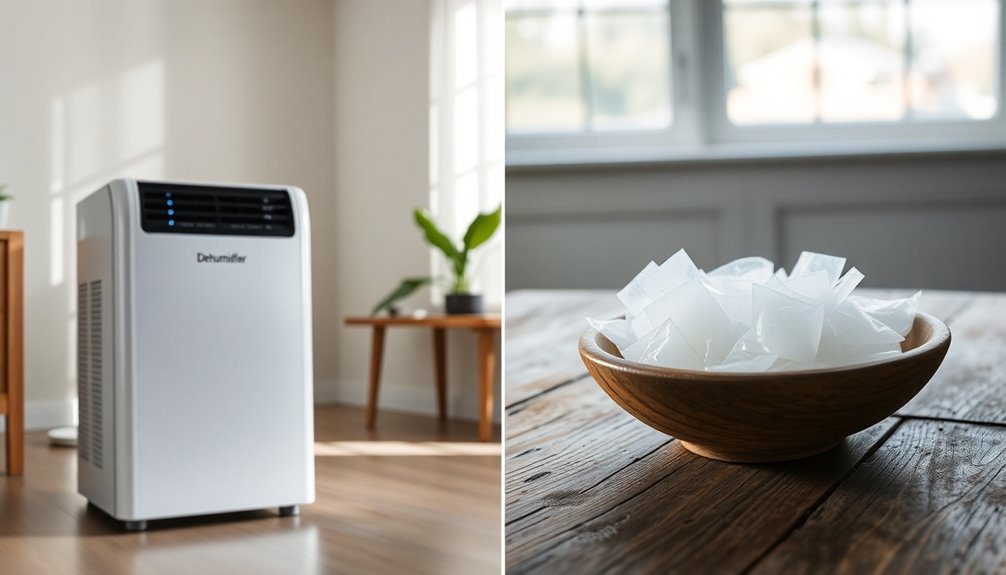
For larger spaces or areas with significant humidity, electric dehumidifiers are your best bet.
To guarantee you're getting the most out of your unit, follow these best practices for dehumidifiers:
- Optimal Placement: Position the dehumidifier in the most humid areas, like basements or laundry rooms.
- Regular Maintenance: Clean or replace filters regularly to maintain airflow; clogged filters can cut efficiency by up to 50%.
- Set Appropriate Humidity Levels: Keep indoor humidity between 30% to 50%. This range prevents mold growth and helps moisture condenses effectively.
- Use in Conjunction with Ventilation: Enhance dehumidifier performance by using exhaust fans and opening windows on dry days to improve air circulation.
- Continuous Drain Option: If your dehumidifier has a continuous drain feature, use it. This saves you from manually emptying the water tank and allows for uninterrupted operation.
Passive vs. Active Solutions
Humidity control can be approached in two main ways: passive and active solutions.
Passive solutions, like silica gel or calcium chloride, offer a low-cost method for smaller, enclosed spaces. They effectively absorb moisture without needing electricity, making them a convenient choice. However, you'll need to periodically replace or recharge these materials to maintain their effectiveness.
On the other hand, active solutions involve electric dehumidifiers, which actively remove moisture from the air. These can achieve lower humidity levels, sometimes as low as 30%, but they come with higher initial and operating costs due to their energy consumption. Desiccant dehumidifiers work well in cooler environments, while compressor models are more efficient in warmer conditions.
While passive solutions may seem cheaper upfront, electric dehumidifiers provide a more robust and long-term solution for larger or varying temperature spaces.
Keep in mind that maintenance differs between the two; silica gel requires minimal upkeep, while dehumidifiers need regular cleaning and maintenance to guarantee peak performance.
Ultimately, the choice between passive and active solutions depends on your specific needs and the space you're looking to dehumidify.
User Experiences and Reviews
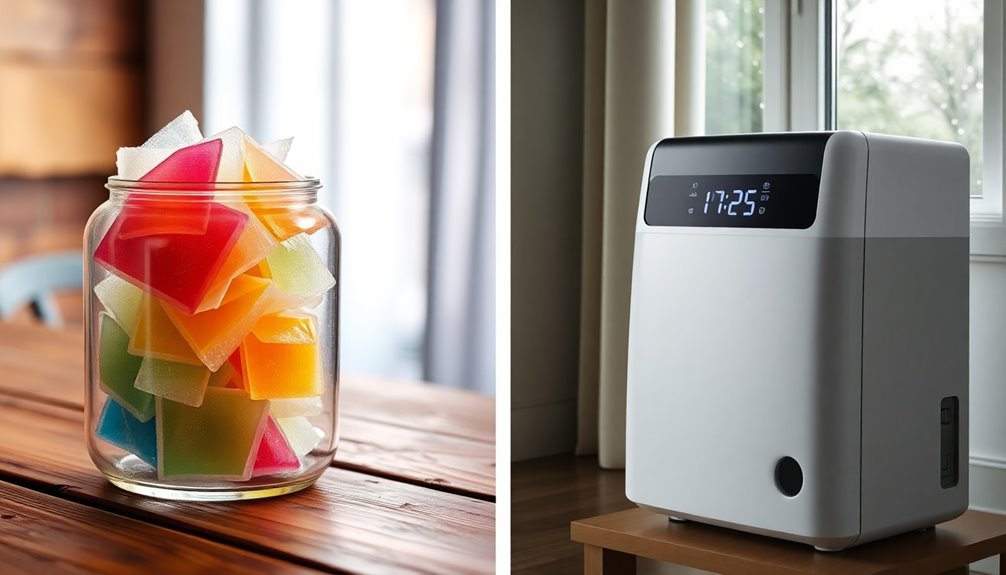
User experiences reveal distinct preferences between silica gel and desiccant dehumidifiers based on specific needs and environments.
Many users appreciate the convenience of silica gel packets for quick fixes, but they often find themselves frequently replacing them.
In contrast, desiccant dehumidifiers, particularly those equipped with a desiccant wheel, provide a more sustainable solution.
Here's what users are saying:
- Silica gel is economical, costing around 34c per litre.
- Desiccant dehumidifiers lower humidity to as low as 30%, even in extreme temperatures.
- Users report desiccant dehumidifiers require less frequent maintenance and replacement.
- Many find the initial investment in a desiccant dehumidifier pays off in larger spaces.
- Silica gel works best in small, enclosed areas, while desiccant dehumidifiers excel in big rooms.
Final Thoughts on Options
Weighing your options between silica gel and desiccant dehumidifiers can lead to a more informed choice tailored to your needs.
If you're dealing with small spaces or occasional moisture issues, silica gel is a low-cost and easy-to-use option. However, keep in mind that rechargeable silica gel requires periodic reactivation, adding some manual maintenance to your routine.
On the other hand, if you face extensive moisture problems or require continuous operation, electric dehumidifiers, especially compressor or desiccant models, offer superior moisture control. They can lower humidity levels considerably, even in extreme temperatures, and can handle larger areas more effectively.
The operating cost for these dehumidifiers can vary, but they often prove more cost-efficient in the long run when considering their ability to manage moisture continuously.
Ultimately, your choice should reflect your specific needs and environment. If you're looking for a quick, inexpensive fix in a confined area, silica gel will do the trick.
For ongoing moisture management and larger spaces, investing in dehumidifiers will save you time and hassle while providing better results.
Additional Resources for Moisture Control
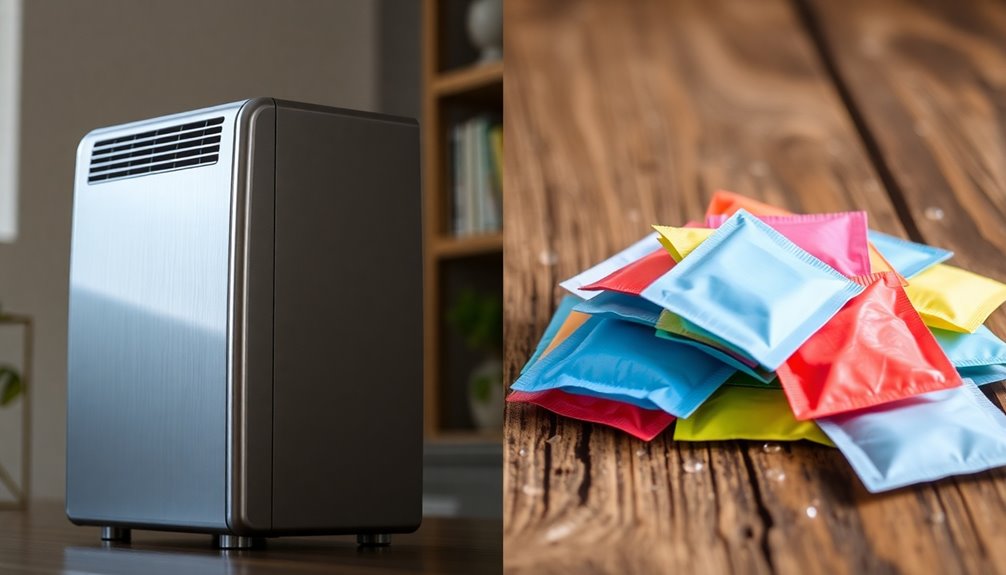
When tackling moisture control, it's essential to explore various resources that can enhance your efforts.
Using a combination of methods can be particularly effective in reducing humidity levels in your space. Here are some options you might consider:
- Silica Gel Packets: Affordable and effective for small areas like closets or storage boxes.
- Rechargeable Silica Gel Dehumidifiers: Regenerate them by heating, providing a sustainable moisture control option.
- Desiccant Dehumidifiers: Although pricier, they can reach lower humidity levels and work efficiently in cold temperatures.
- Electric Desiccant Dehumidifiers: Ideal for larger spaces, they extract moisture at a cost-effective rate, especially in high-humidity conditions.
- Combination Approach: Pair silica gel packets with a dehumidifier to provide immediate moisture absorption while maintaining lower humidity over time.
Conclusion
In the battle against moisture, both silica gel and dehumidifiers wield their unique strengths. While silica gel quietly absorbs humidity like a sponge soaking up a spill, dehumidifiers actively chase away dampness, offering a more powerful solution for larger spaces. Ultimately, it boils down to your needs and budget. Whether you choose the subtle charm of silica or the robust efficiency of a dehumidifier, you're equipped to reclaim your space from the clutches of humidity.

